A Masterpost of Resources on the Traditional Catholic Rite of Betrothal
This post includes information about the history of the celebration of Catholic betrothals. It will be continuously updated.
Rites of betrothal
- Rite of Betrothal in the Roman Ritual
Full text of the Rite of Betrothal as found in Father Philip Weller’s English translation of the Roman Ritual. This is the most commonly used version of the rite.
- Promised in Christ: Solemn Engagement, Crowning of a Bride. Loveland, Ohio: Grailville Publications, 1955. https://archive.org/details/grailville-promised-in-christ
Although the formal engagement has not been in wide use in English-speaking countries, it is very well known in other parts of the world and it is in keeping with Christian tradition that the engagement promises of a young man and woman be exchanged publicly before the altar of God. There is no prescribed form for such a betrothal, and where the custom does exist in the United States, several procedures are in current use. The betrothal in this booklet is an arrangement by the Rev. Philip T. Weller, worked out some years ago on the occasion of the engagement of one of Grailville’s students. This procedure has since been published in Volume I of Father Weller’s translation of the Roman Ritual, and is included here with the kind permission of Bruce and Company of Milwaukee, Wisconsin, publishers of the Ritual. (emphasis added)
- Fenner, Kay Toy. American Catholic Etiquette. Westminster, Md.: Newman Press, 1965.
The canonical, or ecclesiastical, engagement is a custom that is part of a recent movement, fostered both by laymen and clergy, to weave the beauty and symbolism of our liturgy into our practice of our Faith and to invest all the important occasions of our life with a religious or sacramental character…Following is a description of the suggested form of a canonical engagement, as prepared by the Rt. Rev. Martin Hellriegal. (emphasis added)
- Foley, Michael P. Lessard Alexander E. Lessard Angela Foley Alexandra. Wedding Rites: The Complete Guide to a Traditional Wedding. Grand Rapids, Mich.: William B. Eerdmans Pub., 2008.
Traditionally, the first thing to happen after the couple agreed to marry would be a betrothal ceremony. Though many of us have never heard of them before, solemn betrothals were common in Europe and the Middle East long before the birth of Christianity, and they continue to be used by several communities today…It is little wonder, then, that betrothals have been making a minor comeback in the last several years.
Even though solemn betrothals were familiar to Christians in the West from the earliest times up until the 1600s, they were especially popular in France, which retained the custom all the way into the twentieth century. The following is actually a compilation of three French rites: one from the twelfth century, one from the thirteenth, and one from the nineteenth.
- Catholic Church, and The Liturgical Conference. The Book of Catholic Worship. Washington, DC: The Liturgical Conference, 1966.
Note: This excerpt contains a blessing of an engagement, and a rare engagement bible vigil.
Books
Broderick, Robert C. The Catholic Layman’s Book of Etiquette. 1959.
Engagements may be made formal espousals by putting the promise to marry in writing, signed by the parties and the parish priest of the bride or of the place where the contract was made (or before the local ordinary), and before two witnesses. This is not binding in law. It is not generally a practice in the United States.
Kelly, George Anthony. The Catholic Youth’s Guide to Life and Love. Robert Hale: London, 1962.
The betrothal rite. In earlier times, when a man and woman became engaged, they solemnized their agreement in the church by plighting their troth. This ceremony is enjoying a remarkable revival in the United States.
The ceremony is simple and short. You and your spouse-to-be promise before a priest that you will prepare yourselves in the best way possible for the sacred state of matrimony. You assert solemnly that you sincerely intend to wed unless you discover defects that would make marriage undesirable.
This ceremony symbolizes your desire to spend your days before your wedding in trying to make sure that you’re doing the right thing. It doesn’t bind you to marry. Rather, it emphasizes the importance of thorough preparation for marriage and it imbues bride and bridegroom with a sense of the important spiritual nature of the marriage contract.
The betrothal rite will give you a greater sense of the dignity and idealism of married life. It will dispose you to treat it with the reverence it deserves.
Witte, John Westminster John Knox Press. From Sacrament to Contract : Marriage, Religion, and Law in the Western Tradition. Louisville, KY: Westminster John Knox Press, 2012.
pg. 327: Second, the Western tradition has learned to distinguish between betrothals and espousals, engagements and weddings. Betrothals were defined as a future promise to rnarry, to be announced publicly in the local community and to be fulfilled after a suitable waiting period. Espousals were defined as the present promise to marry, to be celebrated- in a public ceremony before civil and/or religious officials. The point of a public betrothal and waiting period was to allow couples to weigh the depth and durability of their mutual love. It was also to invite others to weigh in on the maturity and compatibility of the couple, to offer them counsel and commodities, and to prepare for the celebration of their union and their life together thereafter. Too long an engagement would encourage the couple to fornication. But too short an engagement would discourage them from introspection. Too secret and private a marriage would deprive couples of the essential counsel and gifts of their families and friends. But too public and routinized a marriage would deprive couples of the indispensable privacy and intimacy needed to tailor their nuptiais to their own preferences. Hence the traditional balance of engagement and wedding, of publicity and privacy, of waiting and consummating.
Articles
“Decree Concerning Sponsalia and Matrimony.” The American Catholic Quarterly Review (October 1907).
Foley, Michael P. . “Betrothals: Their Past, Present, and Future.” Studia Liturgica 33 (2003): 37-61.
“A Liturgical Rite of Betrothal,” New Liturgical Movement, 2019, http://www.newliturgicalmovement.org/2019/10/a-liturgical-rite-of-betrothal.html#.Xbhzf0ZKi70.
Lawler, Michael G. , and Gail S. Risch. “A Betrothal.” U.S. Catholic (June 2007): 18-22.
Szabó, András Péter, and Matthew Caples. “Betrothal and Wedding, Church Wedding and Nuptials: Reflections on the System of Marriages in Sixteenth- and Seventeenth-Century Hungary.” The Hungarian Historical Review 3, no. 1 (2014): 3-31. http://www.jstor.org/stable/43265189.
Balatonyi, Judit. “From Deviancy to Norm: An Alternative Betrothal Rite in Gyimes.” Acta Ethnographica Hungarica Acta Ethnographica Hungarica 63, no. 1 (01 Jun. 2018 2018): 33-48. https://doi.org/10.1556/022.2018.63.1.3.
Newspaper clippings
19th century
“An Italian Betrothal.” The Catholic Telegraph, August 29 1895. https://thecatholicnewsarchive.org/?a=d&d=TCT18950829-01.2.58.
In Italy a formal betrothal is considered almost as binding and sacred as marriage itself, and a breach of promise, especially on .the girl’s side, is regarded with intense indignation. A girl who breaks her engagement is called a civetta — an owlet — possibly because owlets are used in Italy as decoys for ensnaring other birds. The epithet sticks to the girl for life and often proves fatal to her matrimonial chances.
1900s
“Wedding Rings.” The Catholic Telegraph, August 1 1901. https://thecatholicnewsarchive.org/?a=d&d=TCT19010801-01.2.16.
In ancient times the ceremony of betrothal was really more solemn than marriage, and the betrothal ring was considered the more important of the two. The marriage ceremony was looked upon as a mere ratification of the betrothal contract. The Church very rightly then punished by excommunication any violation of the betrothal contract. It is interesting to know that the first part of our marriage service down to the “I will” is a remnant of the old betrothal service.
“Sacredness of Betrothel.” The Catholic Telegraph, December 4 1902. https://thecatholicnewsarchive.org/?a=d&d=TCT19021204-01.2.37.
So sacred does the Catholic Church regard marriage that it does not allow either party to a betrothal to disregard the promise of marriage without a good and sufficient reason. Non-Catholics throughout the east were greatly surprised last week at the following dispatch which appeared in a number of local papers: Fall River, Mass., Nov. 24. —Miss Mary McDonald, plaintiff in the breach-of-promise-of-marriage suit against Patrick Kieran, the wealthy superintendent of the Fall River Water Works, in which she got $15,000, has released Mr. Kieran from his promise to marry her and he is at liberty now to enter into the marriage contract with another woman. Miss McDonald had blocked his effort to get married by filing a protest with Bishop Harkins, of Providence. This became public when Mr. Rieran applied to the ehurch for a dispensation to marry Miss McDonald’s rival. This request was denied. He insisted upon the dispensation and an ecclesiastical court was to have been convened this week to determine the issue. But Miss McDonald changed her mind to-day and filed with Bishop Harkins her written withdrawal of her objection to Mr. Kieran’s marriage to another.
“Priests Here to Disregard New Betrothal Law.” St. Louis Post - Dispatch, February 18 1908.
The new Catholic marriage laws, issued by Pope Pius, which are to become effective after Easter, and which were published for the first time here in the Sunday Post-Dispatch, Feb.2, will be disregarded in so far as they apply to engagements in the United States.
“Catholic priests here do not regard engagements seriously,“ the Rev. Father D. S. Phelan of Our Lady of Mount Carmel Catholic Church told a Post-Dispatch reporter Tuesday. “In Europe they are binding and almost equivalent to marriage, but here – why hear a girl gets engaged one day and breaks at the next. The passing of the ring isn’t regarded is really binding – the girl just send it back. You see, in Europe the girls don’t choose their husbands. The men do the choosing, and when the betrothal is entered into it is final. No person can be married they are well engaged to another person – but here, we never ask anything about previous or present engagements…
The new laws are issued for the whole world, and are to be interpreted according to conditions in various places. They are extremely radical, particularly in the provision that no Catholic can be married except by a priest. Heretofore, we have been lenient about civil marriages, but the new laws for bid that.”
“Catholics’ New Law.” The Washington Post, April 19 1908.
“The new legislation does not impose on people about to marry,” the Archbishop declares, “an obligation to make formal prenuptial engagements in writing and before witnesses as a prerequisite for marriage. They may be married, as heretofore, after a simple verbal promise of marriage given to each other.“
This is a liberal interpretation of the clause “sponsalia” of the papal decree, which directs that, to be valid and canonical, engagements should be “drawn up in writing duly signed by the parties contracting sponsalia, and attested by proper witnesses.”
“Rt. Reverend Bishop O’Dea Expounds Laws of Church on Pre-Nuptial Engagements.” The Catholic Northwest Progress (Seattle, WA), April 10 1908. https://washingtondigitalnewspapers.org/?a=d&d=CATHNWP19080410.2.2&srpos=54.
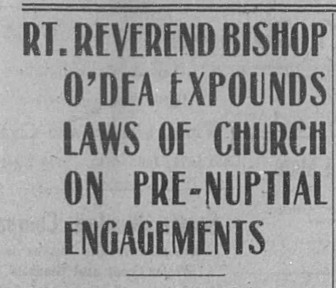
Whoever contemplates marriage should be there in mind that it is above all things a serious and important obligation. Betrothal or engagement has always been regarded by the churches binding. For the future, after next Easter Sunday, no engagement will be considered of any authority by the Church unless made in writing and signed by both parties with the witness either of a priest or of two other persons.
“The Marriage of Catholics—Laws Take Effect Easter Sunday.” The Monitor, April 4 1908. https://thecatholicnewsarchive.org/?a=d&d=tmon19080404-01.2.2.

Only those matrimonial engagements are considered to be valid and to beget canonical effects which have been made in writing, signed by both parties, and by either the parish priest or the Ordinary of the place, or at least by two witnesses.
Esopo, Father. “The Catholic Betrothal Rule.” St. Louis Post - Dispatch, February 25 1908.
As the Post-Dispatch printed on the 18th…Father Phelan told: “Catholic priests here do not regard engagements seriously.” Well, if you believe so now, after Easter he must change his idea regarding engagements seriously according to the new betrothal law. The new law is of the world and the Catholic American girls have now a good chance to bind fellows if their engagements are written and signed in presence of pastor or two witnesses. In the past the poor fellows were annoyed by girls, but now they can complain to the pastor against their sweethearts, showing written and signed engagements and pastor must inquire about them because the girl fell in so called impedimentum impediente. It means the girl must receive permission from the bishop if she wishes to be married to another fellow. For all above reasons the priest here must regarding new betrothal law and girls in America may bind fellows and vice versa.
1910s
“Thoughts on Marriage.” The Catholic Northwest Progress (Seattle, WA), August 3 1917. https://washingtondigitalnewspapers.org/?a=d&d=CATHNWP19170803.2.46&srpos=94.
The work of the Council of Trent in the matter of marriage was confined more particularly to defending and defining the sacramental character of marriage… The matter of betrothal, or promise of marriage, was passed over rather lightly by the council. The consequence was that many difficulties arose. Engagements to marry were entered into lately and they are binding contractual character was held in slight regard. The Council recognized betrothals but prescribed no formality for their validity. Whether it was a solemn betrothal and public or a secret engagement to marry it was equally invalid and an impediment. This frequently worked grave injustice, especially in those countries where the canon law on marriage was recognized and enforced by the civil courts. The history of betrothal brings us back to the practices that were common amongst the Jews and Romans whose laws and customs influenced the early church…
“After Dinner Story “in the Path of the Conquerors”: A Romance of Spain’s Great Day.” Our Sunday Visitor, April 29 1917. https://thecatholicnewsarchive.org/?a=d&d=OSV19170429-01.2.17.
“Know ye all who are present, that Dona Ysabel is not free to contract marriage with this scoundrel Inigo de Oliavarez: she is betrothed! to me.” “Indeed,” said Fonseca, “and was this contract in writing? And was the betrothal before two witnesses? And with the consent of the lady’s guardian? No? Ah! then, my young friend, your betrothal is null and void.”
1920s
“Question Box.” The Catholic Northwest Progress (Seattle, WA), August 20 1920. https://washingtondigitalnewspapers.org/?a=d&d=CATHNWP19200820.2.44&srpos=106.
There is no law of the Church compelling a young couple contemplating marriage to enter a solemn betrothal. The Church blesses such a betrothal and the young couple entering into it with the proper dispositions will undoubtedly receive special graces to preserve them from any sin.
“Catholic Marriage Laws According to New Code.” Our Sunday Visitor, May 20 1923. https://thecatholicnewsarchive.org/?a=d&d=OSV19230520-01.2.3.
Among Catholics a binding marriage engagement arises only from a written contract signed by both parties and witnessed by the pastor, or in lieu of the pastor, by two witnesses, (Canon 1017).
Smith, Reverend Matthew. “Church Has Special Way for Betrothing of Couples.” The Register (Denver, CO), June 3 1928. https://archives.archden.org/islandora/object/archden%3A5440.

The Catholic Church has a formal method of betrothing couples, although it is rarely used in this country. Her children are free to use it or not as they wish. Only when this formal method is used does the Church law officially recognise a betrothal.
1930s
“Christian Betrothal Studied At Congress.” Catholic News Service, May 29 1933. https://thecatholicnewsarchive.org/?a=d&d=cns19330529-01.1.36.
About 800 delegates, from different sections of France, have been engaged in studying “Christian betrothing” at the eleventh national congress of the Association of Christian Marriage held at Rouen.
Cavanagh, Reverend John. “Betrothal of Couples Is Favored by Church.” The Register (Denver, CO), December 13 1936. https://archives.archden.org/islandora/object/archden%3A6294.

The engagement of people to marry has, in recent years, lost its identity as a hallowed institution. Breach of promise suits have become a regular filler for the columns of the daily press. That the actions of an adventuress should be favored by the metropolitan dailies does not speak well for the moral ideals of the public…Alter centuries of experience in handling pre-nuptial problems of the faithful, it is not surprising that the Church has compressed witin her canons the wisdom of a Divinely-founded oracle. Before the promise of marriage is considered valid in the eyes of the Church, the betrothal must be made in writing, signed by the parties and by either the pastor or the local Ordinary or at least two witnesses (Canon 1017).
1940s
“Old Catholic Ceremony of Betrothal Revived at Montreal Oratory.” Catholic News Service, February 3 1941. https://thecatholicnewsarchive.org/?a=d&d=cns19410203-01.1.20.
An ancient rite, the Catholic ceremony of betrothal, was revived yesterday at the Oratory of Bt. Joseph with the Most Rev. Joseph Charbonneaui Archbishop of Montreal, presiding. (epmhasis added)
“Ask and Learn.” The St. Louis Register, April 4 1941. https://thecatholicnewsarchive.org/?a=d&d=SLR19410404-01.2.64.29.
The Church declares that betrothals which do not comply with certain formalities have no binding force in either the civil or ecclesiastical forums.
“Formal Betrothals Urged as Check on Hasty Marriages.” The St. Louis Register, September 4 1942. https://thecatholicnewsarchive.org/?a=d&d=SLR19420904-01.2.64.
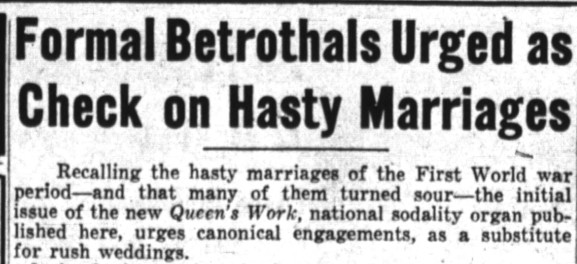
In its October number, shortly to be released, the sodality mouthpiece explains the seldom used formal and solemn engagement, in which a couple pledge their troth before the altar, in the presence of two witnesses and a priest, and deposit a copy of the contract with the pastor of the girl’s parish. (emphasis added)
“‘Forget It,’ Is Priest’s Advice on War Romance.” The St. Louis Register, June 4 1943. https://thecatholicnewsarchive.org/?a=d&d=SLR19430604-01.2.60.16.
To those who have met since tha outbreak of the war and the consequent threat of conscription, Monsignor Begin said: “If you know each other well enough and have considered all the consequences of marriage, enter a solemn public form of engagement, mutually binding each other to marriage when the war is over.”
“Weddings.” The St. Louis Register, September 3 1943. https://thecatholicnewsarchive.org/?a=d&d=SLR19430903-01.2.63.65.
An ecclesiastical engagement has been made by Dolores Bryne…The ceremony of engagement, which was held at the high altar in Holy Cross church…consisted of a promise before two witnesses to lead humble, holy, and pure lives, and to attend the sacraments. The pledge was later signed in the sacristy.
Schmiedeler OSB, Reverend Edgar “The Engagement or Betrothal.” The Catholic Northwest Progress (Seattle, WA), March 14 1947. https://washingtondigitalnewspapers.org/?a=d&d=CATHNWP19470314.2.73&srpos=163.
It should be clear that engagements involve no’marital responsibilities and grant no marital rights or privileges.
“236 Take Part in Traditional Ceremony on Espousal Feast.” Catholic News Service, February 2 1948. https://thecatholicnewsarchive.org/?a=d&d=cns19480202-01.1.100.
In the presence of Archbishop Joseph Charbonneau of Montreal, 118 young couples took part in a canonical engagement ceremony at St. Joseph’s Oratory on the feast of the Espousal of Mary and Joseph. A large congregation witnessed the now traditional ceremony in which the 2j6 young people took part. (emphasis added)
1950s
“Betrothal Rite.” The St. Louis Register, March 2 1951. https://thecatholicnewsarchive.org/?a=d&d=SLR19510302-01.2.72.
Miss Margaret Ann Muehlenkamp (above)…became betrothed to Charles R. Godar in a ceremony…before the shrine of Our Blessed Mother in Perpetual Help church, Kansas City.
Kekrisen, Reverend Robert E. . “Ask and Learn.” The Register (Denver, CO), 1953. https://archives.archden.org/islandora/object/archden%3A7368.
When the betrothal of two Catholics fulfills all the requirements demanded by canon law for validity, it produces an obligation that binds in conscience (Ayrinhac-Lydon, Marriage Legielation tn the New Code of Canon Law, p. 20). It is true, however, that most modern engagements cannot be construed as “formal betrothals” according to ecclesiastical usage.
“The Camera Reports.” The St. Louis Register, March 26 1954. https://thecatholicnewsarchive.org/?a=d&d=SLR19540326-01.2.51.
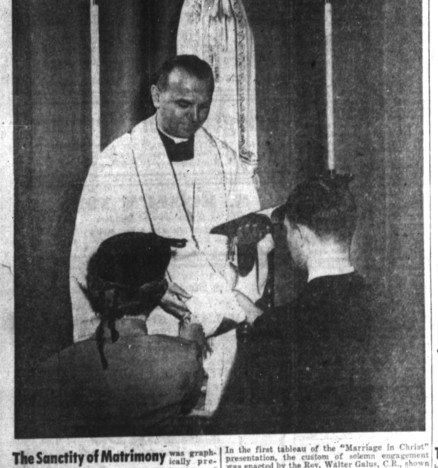
The Sanctity o( Matrimony was graphically presented by Fontbonne College students Sunday and Monday, March 21 and 22, to illustrate how all phases of married life have been blessed by God. In the firat tableau of tha “Marriage in Christ presentation, the custom of solemn engagement was enacted by the Rev. Walter Galus C.R.
“Solemn Engagement Rite Fast Gaining Popularity.” The St. Louis Register, December 24 1954. https://thecatholicnewsarchive.org/?a=d&d=SLR19541224-01.2.81.17.

After coming up the aisle, the couple promise to marry one day “according to the ordinance of God and Holy Church.” After the priest has blessed the engagement ring, the man places it on his fiancee’s finger. The couple kiss the Missal on the page imprinted with the Crucifixion. The rite ends as the couple sign a document to the effect that they “have this day promised the eventual consecration of one to the other in the sacrament of Matrimony.” Priest and witnesses also sign the paper. Finally the couple pray for grace to “spend of our engagement soberly, piously. and justly, awaiting the blessed consummation of that union.”
“Formal Betrothal.” The St. Louis Register, December 24 1954. https://thecatholicnewsarchive.org/?a=d&d=SLR19541224-01.2.81.66.
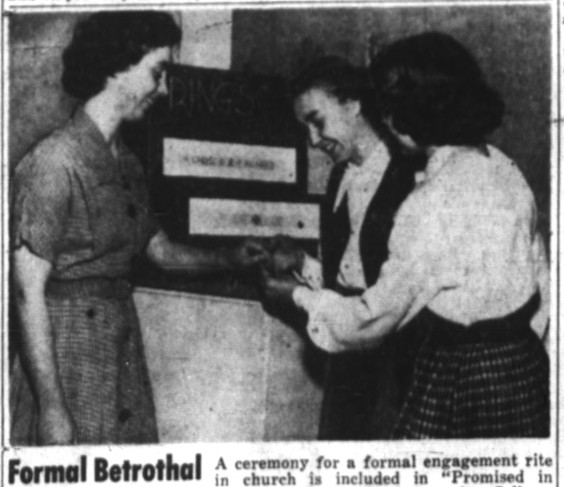
A ceremony for a formal engagement rite in church is included in “Promised in Christ,” a booklet published by the Grailville Community College, Loveland, O.
“Engagements Solemnized in New Liturgical Movement.” Catholic News Service, December 22 1954. https://thecatholicnewsarchive.org/?a=d&d=cns19541222-01.1.11.
The ceremony, which is fast gaining popularity, is performed in the presence of a priest and two witnesses. (emphasis added)
“An Engagement Is Solemnized.” The Catholic World in Pictures, December 20 1954. https://thecatholicnewsarchive.org/?a=d&d=cwp19541220-01.2.6.
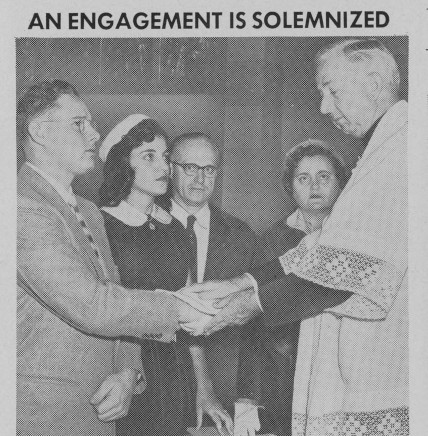
In a liturgical movement that is rapidly gaining ground in the United States, engaged couples are solemnizing their betrothals. (emphasis added)
“Betrothal Rite Is Solemnized at Cure D’ars.” The Register (Denver, CO), May 5 1955. https://archives.archden.org/islandora/object/archden%3A8073.
Father John Haley officiated at a very old Church ceremony — a solemn betrothal ceremony — between Fred Muenchrath and Alice Reinig on April 8 in Cure d’Ars Church.
“Ancient Church Ceremony.” The St. Louis Register, August 12 1955. https://thecatholicnewsarchive.org/?a=d&d=SLR19550812-01.2.2.
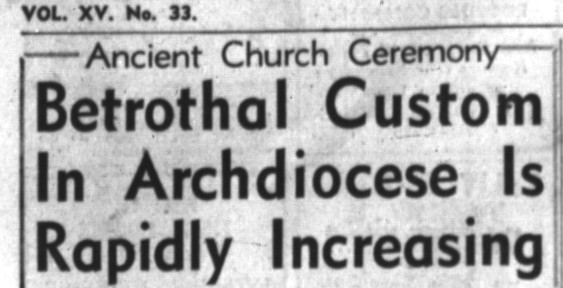
The trend marks a return to ancient customs of the Church, which had in turn been borrowed in part from ceremonials of the Jews aad Romans…
Forms Vary
The forms that a modern engagement ceremony may take vary considerably from these olden practices, but they nevertheless retain a strong emphasis on the importance and significance of the etep that is being taken. (emphasis added)
“Betrothal Prayers.” The St. Louis Register, October 28 1955. https://thecatholicnewsarchive.org/?a=d&d=SLR19551028-01.2.127.
Miss Joyce Plante, senior of Maryville College, and her fiance, Donald Kannatt Osborne, read over prayers for their solemn bethrothal scheduled to take place in the chapel ef Maryville Collage, St. Louis, Sunday, Oct. 30.
“Solemn Engagement.” The St. Louis Register, March 16 1956. https://thecatholicnewsarchive.org/?a=d&d=SLR19560316-01.2.141.75.
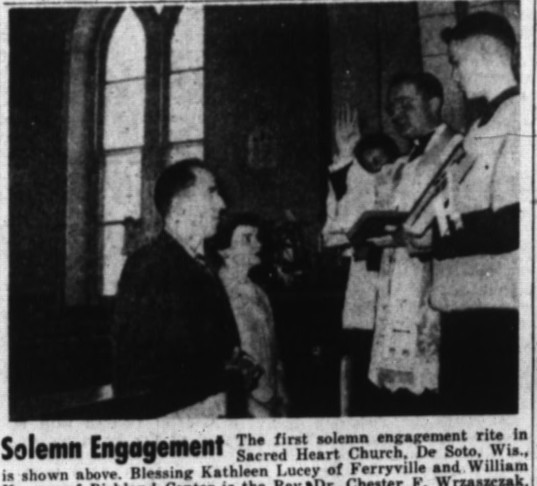
Th# first solemn engagement rite in Sacred Heart Church. De Soto. Wis. is shown above. Blessing Kathleen Lucey of Ferryville and William Keegan of Richland Center is the Rev. Dr. Chester F. Wrzasczcak, pastor. Father Wrzasczcak, defender of the marriage bond of the La Crosse Diocese, is promoting the use of the solemn engagement rite with books, pamphlets, and articles.
Thomas SJ, Father John L. “Is There an Ideal Length for the Engagement Period?” The Catholic Northwest Progress (Seattle, WA), September 13 1957. https://washingtondigitalnewspapers.org/?a=d&d=CATHNWP19570913.2.170&srpos=180.
Before answering your questions it might be well to point out that the term emgagement is used rather loosely in our country. At one time it represented an external rite and a formal promise to marry pronounced before witnesses such as the relatives or a representative of the Church. The Church has a formal engagement or betrothal ceremony although changing social conditions cause it to be used rather infrequently. (emphasis added)
“KYAK Officers Are Betrothed.” The Clarion Herald, Ju;y 6 1958. https://thecatholicnewsarchive.org/?a=d&d=cher19580706-01.1.6.
The betrothal rite was used for the first time by KYAK members, but its use is encouraged in the organization.
“Betrothals.” The Monitor, May 16 1958. https://thecatholicnewsarchive.org/?a=d&d=tmon19580516-01.2.117.
The engagement was solemnized in a betrothal ceremony followed by the celebration of Holy Mass at St. Albert’s college in Oakland. Father Kevin Carr, O P , officiated.
“Ask and Learn.” The Register (Denver, CO), May 14 1959. https://archives.archden.org/islandora/object/archden%3A6228.
Engagement begets a serious obligation in justice to contract marriage afterwards, unless there is a good reason to the contrary.
1960s
“Pre-Cana Meet at St. Mary’s.” The Monitor, April 1 1960. https://thecatholicnewsarchive.org/?a=d&d=tmon19600401-01.2.121.
A unique feature of the St Mary’s conference will be the ceremony of the Solemn Betrothal Rite wherein members of the college student body will sanctify their promises of engagement.
“Solemn Engagement.” The Catholic Advocate, February 21 1963. https://thecatholicnewsarchive.org/?a=d&d=ca19630221-01.2.80.
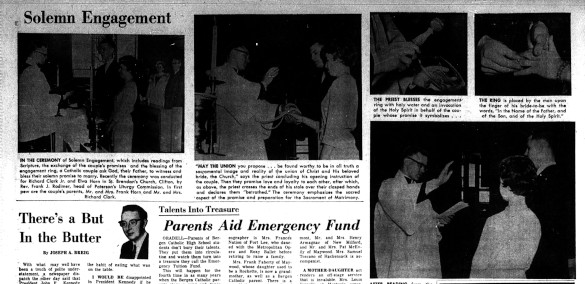
In the ceremony of Solemn Engagement, which includes readings from Scripture, the exchange of the couple’s promises and the blessing of the engagement ring, a Catholic couple ask God, their Father, to witness and bless their solemn promise to marry. (Note: Based on the details provided, this ceremony appears to be Fr. Weller’s rite of betrothal.)
“Solemn engagement rite ideal marriage preparation.” The Clarion Herald, May 7 1964. https://thecatholicnewsarchive.org/?a=d&d=cher19640507-01.1.9.
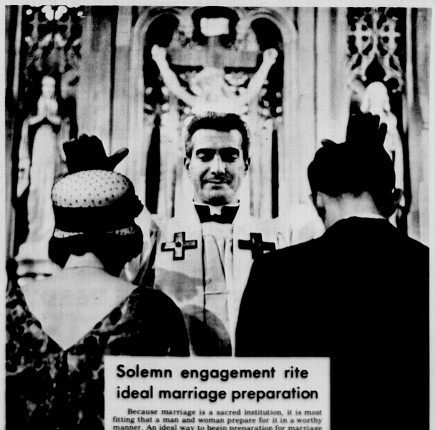
Solemn engagement is not the same as canonical engagement envisioned by canon 1017. The binding legal effects of canonical engagement have militated against its use except in rare instances. The form for solemn engagement now employed includes the spiritual benefits of canonical engagement without its legalistic effects.
The ceremony is a simple one. The couple along with two witnesses declare their intention to marry as they kneel before the altar in the presence of the parish priest. He encourages them diligently to prepare for their marriage in Christ through prayer and reception of the sacraments. It is also customary for the couple and witnesses to sign a document embodying these ideals.
“Short Engagement Seen Best for All.” The Clarion Herald, April 30 1964. https://thecatholicnewsarchive.org/?a=d&d=cher19640430-01.1.22.
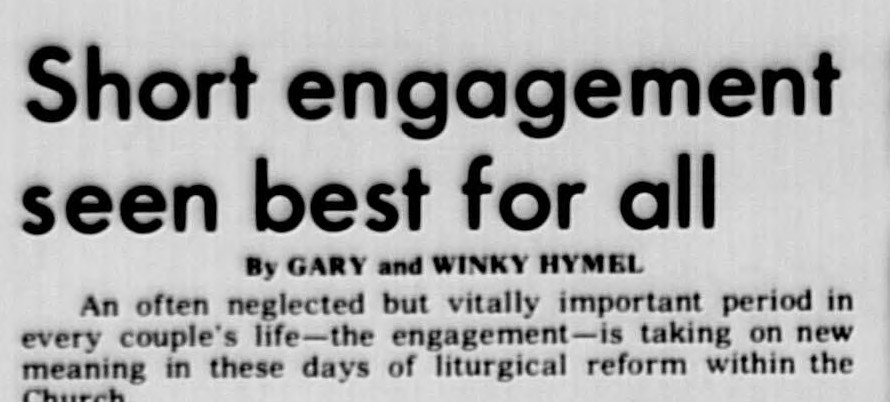
But today there is a return to the practice of the solemn engagement in which the couple appear before the priest at the altar and solemnly pronounce the bethrothal in the presence of two witnesses. All then sign a document.
“A Preliminary.” The Catholic Advocate, March 24 1966. https://thecatholicnewsarchive.org/?a=d&d=ca19660324-01.2.175.11.
A ring is not enough. Many couples are now sealing their engagement with a signed contract, a ceremony complete with candles and witnesses, and the blessing of the Church. They ask their pastor for a betrothal ceremony. Before the altar the couple stand and recite their promises in the presence of priest and witnesses. “We the undersigned promise to one another by this ecclesiastical engagement marriage in Christ.” In addition, they promise “by the frequent devout reception of the holy sacraments, by prayer and charity, by mutual respect and chastity, we shall assist one another in preparing worthily for the blessed day of our marriage in Christ.” They conclude by asking God’s Mother “to carry our promise to the throne of God and to obtain for us His grace and blessing.” The priest asks the couple and the witnesses to sign the betrothal document, then stamps it with the parish seal, and hands it to the couple, now formally engaged. “We show it to everyone,” one young bride said, “along with our wedding pictures.” The vows bind only for the time of the engagement. Should the couple decide not to marry, the contract no longer applies.
1970s
“Vatican Daily Rebuffs Betrothal Proposal.” Catholic News Service, March 15 1971. https://thecatholicnewsarchive.org/?a=d&d=cns19710316-01.1.21.
In an apparent swipe at a former archbishop of Canterbury, L’Osservatore Romano, the Vatican daily, stressed the need for chastity for engaged couples. An article on the subject appeared in the March 15 edition signed with the pen name “The Theologian.” The article, at least in part, seemed to be a reaction to a recent proposal by Lord Geoffrey Fisher of Lambeth, former Anglican primate and archbishop of Canterbury. His proposal was that engaged couples should be permitted to enter a ceremony of “bethrothal” after which sexual relations would be approved, even before formal marriage.
“Pre-Marriage Lectures Set for Mondays.” Pittsburgh Catholic, May 24 1974. https://thecatholicnewsarchive.org/?a=d&d=TPC19740524-01.2.27.
First of the summer lectures will begin on Monday evening July 8. They will continue each Monday through Aug. 12, the series closing on that final Monday with a Mass of Solemn Engagement.
Franklin, James. “Catholics Reviving Betrothal Custom.” Boston Globe, December 5 1977.
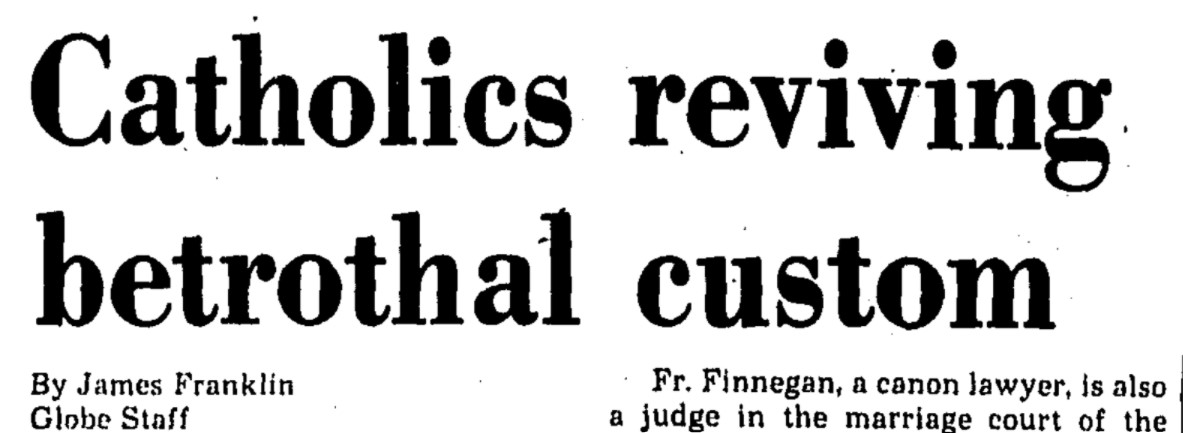
The Roman Catholic Church is moving to revive the custom of betrothal before marriage, says Reverend John Finnegan, professor at Pope John XXIII Seminary in Weston.
Fr. Finnegan told a weekend conference on marriage preparation, sponsored in Newton by the archdiocese of Boston, that “within the next 20 to 25 years, we will have a full catechumenate (or training program) for all engaged couples.” (…)
Betrothal could begin at least six months, and possibly a year, before the marriage with the formal act of commitment and include “rights of passage“ at points during the preparation, Fr. Finnegan suggested. (…)
As the practice develops, there would be “surrogate families” to support and encourage the couple after marriage, in which “marrieds would take responsibility to care for other marrieds in their parish,“ Fr. Finnegan said. (…)
The church faces a “haunting challenge,“ he said. “From the social point of view, marriage is more difficult to sustain today.” (…)
But there has been a recent a shift in the church’s understanding of the ability to marry. “We in the church now understand that hereditary problems, abuse of drugs or alcohol, for instance, can prevent the establishment of a community of life and love with the partner,” he said.
Church courts are granting annulments where these problems are found, Fr. Finnegan said, one reason the number of annulment granted each year in Boston has risen from about a dozen annually to 650 last year.
The betrothal period would help the couple and their church determine if they are ready to make a commitment to each other and to understand that marriage is “conditioning for service to others,“ he said.
“Canon Lawyer Advocates Return of Betrothal.” The Catholic Transcript, December 30 1977. https://thecatholicnewsarchive.org/?a=d&d=CTR19771230-01.2.47.
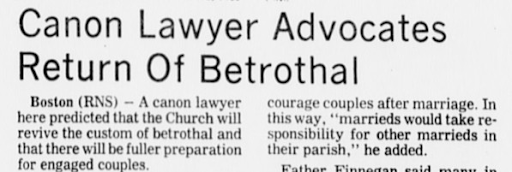
A canon lawyer here predicted that the Church will revive the custom of betrothal and that there will be fuller preparation for engaged couples.
1980s
Loschlavo, Linda “Engaged Encounter Preparation Tor a Lasting Marriage by Linda Ann " Catholic News Service, January 2 1984. https://thecatholicnewsarchive.org/?a=d&d=cns19840102-01.1.16.
Our Engaged Encounter weekend closes with a special betrothal Mass.